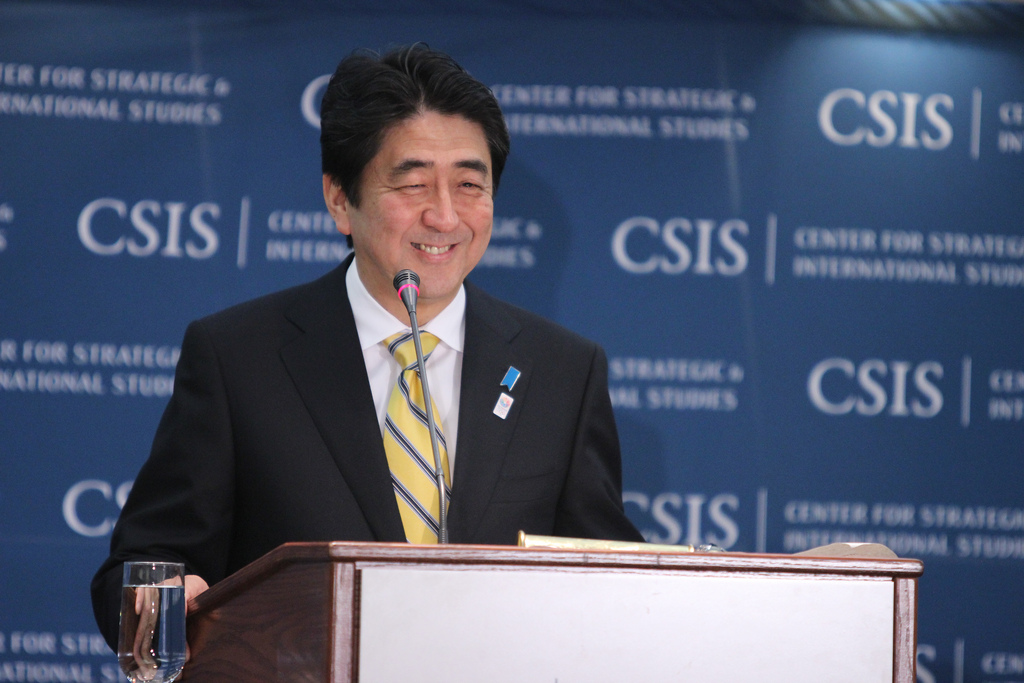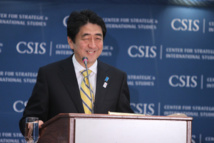Today, much of the rich part of the world is remarkably more similar to Japan: a chronically low interest rate, inflation and the exorbitant level of sovereign debt.
Perhaps that is why many governments are closely watching how Prime Minister Shinzo Abe, who won the elections in 2012 with the promise of economic renaissance, is seeking a way out of the difficult situation, happened with the Japanese economy. His task was much harder than expected earlier. The country need not steady, but vigorous growth that would allow Japan to take control of a huge public debt.
Abe is focused on three main areas: fiscal stimulus, easing monetary policy and structural reforms. In September this year, he aired a more specific objective: increase in nominal Japan’s GDP by 20%, to 600 trillion yen ($ 5 trillion) from the current 500 trillion yen (approximate level of the last 20 years).
Abe’s measures were able to move the Japanese economy away from its standing pat position. Nominal GDP, which measures growth without inflation, rose by 6% from the end of 2012. Approximately half of this increase accounted on higher prices. The unemployment rate also declined from 4.3% to 3.4%.
However, these rates are still extremely low. Moreover, the recovery has unexpectedly stalled in the II quarter. Prices began to decline again, and during the summer, inflation was much lower than the target of 2%, set by the Bank of Japan, says the British magazine The Economist.
Return to a normal monetary policy today seems distant like never before. October 30, The Bank of Japan has disappointed the market by refusing to accelerate the pace of asset purchases, although it is still purchasing government bonds for 80 trillion yen a year and promises to increase the volume, if inflation will remain low.
Meanwhile, Japan's sovereign debt of 240% of GDP (perhaps the highest in the world) continues to increase. The debt market is surprisingly comfortable with this figure: thirty-year bond yields in Japan is only 1.36%. This is partly explained by the fact that the Japanese possess a large number of bonds. The remaining part is owned by the central bank.
However, very few economists believe the boom in borrowing will last long. As the number of Japanese workers who retire rises higher, domestic savings decline, with sharply increase in spending on elderly people. Even a slight increase in borrowing costs could lead to insolvency.
A report issued in 2013 said that to stabilize the debt, Japan needed tax revenues from 30% to 40% of total consumption, or equivalent of the consumption tax rate of around 60%. Other studies are not so categorical, but all of them, however, indicate the need for more radical steps than proposed by Abe’s government (raising the consumption tax to 10%, planned for October, has been postponed). However, at the current rate of growth, any sharp increase in taxes or a reduction in expenditure may return to Japan into recession.
Higher inflation is the only way out of this situation. If nominal GDP has been growing by only 2% a year since 1992, the ratio of debt to GDP would have be only 83% (or as in America). However, a simple increase in wages and prices, as experience shows, is not so easy to implement. Only last year, asset purchase program carried out by the Bank of Japan's has brought the Japanese government’s share of the debt in the ownership of the central bank from 23% to 32%.
Despite low unemployment, the weak yen and a sharp rise in stock prices, the inflation rate did not exceed zero point at any time during Abe’s reign. A more ambitious inflation target (perhaps 4%) would have helped if the market believed in it. However, the regulator’s inability to achieve even target of 2%, established in January 2014, dramatically shaken confidence in the Bank of Japan.
Still, the rising sun have some options. At the current rate of purchase, in 2020 the central bank will have two-thirds of government bonds in its ownership. If we increase the purchase to 100 billion yen a year, the Bank of Japan will hold almost all outstanding public debt by 2026, In this case, the government would owe money to themselves; payments of the Bank of Japan’s debts would return to government as seigniorage (income derived from the issue of money).
Monetizing the debt meets all the standard of economic definition of insanity. Orthodox economists may say that this will inevitably lead to rapid inflation. Yet, this is exactly what Japan has been unsuccessfully trying to achieve for the past two decades. Taking into account the debt crisis as an alternative, monetary madness does not look so bad.
Other governments will understandably be horrified if Japan voluntarily chooses this way. Monetization is certainly a Pandora's box with economic risks. However, as recent experience has shown, other economies are likely to follow Japan’s steps.
source: economist.com
Perhaps that is why many governments are closely watching how Prime Minister Shinzo Abe, who won the elections in 2012 with the promise of economic renaissance, is seeking a way out of the difficult situation, happened with the Japanese economy. His task was much harder than expected earlier. The country need not steady, but vigorous growth that would allow Japan to take control of a huge public debt.
Abe is focused on three main areas: fiscal stimulus, easing monetary policy and structural reforms. In September this year, he aired a more specific objective: increase in nominal Japan’s GDP by 20%, to 600 trillion yen ($ 5 trillion) from the current 500 trillion yen (approximate level of the last 20 years).
Abe’s measures were able to move the Japanese economy away from its standing pat position. Nominal GDP, which measures growth without inflation, rose by 6% from the end of 2012. Approximately half of this increase accounted on higher prices. The unemployment rate also declined from 4.3% to 3.4%.
However, these rates are still extremely low. Moreover, the recovery has unexpectedly stalled in the II quarter. Prices began to decline again, and during the summer, inflation was much lower than the target of 2%, set by the Bank of Japan, says the British magazine The Economist.
Return to a normal monetary policy today seems distant like never before. October 30, The Bank of Japan has disappointed the market by refusing to accelerate the pace of asset purchases, although it is still purchasing government bonds for 80 trillion yen a year and promises to increase the volume, if inflation will remain low.
Meanwhile, Japan's sovereign debt of 240% of GDP (perhaps the highest in the world) continues to increase. The debt market is surprisingly comfortable with this figure: thirty-year bond yields in Japan is only 1.36%. This is partly explained by the fact that the Japanese possess a large number of bonds. The remaining part is owned by the central bank.
However, very few economists believe the boom in borrowing will last long. As the number of Japanese workers who retire rises higher, domestic savings decline, with sharply increase in spending on elderly people. Even a slight increase in borrowing costs could lead to insolvency.
A report issued in 2013 said that to stabilize the debt, Japan needed tax revenues from 30% to 40% of total consumption, or equivalent of the consumption tax rate of around 60%. Other studies are not so categorical, but all of them, however, indicate the need for more radical steps than proposed by Abe’s government (raising the consumption tax to 10%, planned for October, has been postponed). However, at the current rate of growth, any sharp increase in taxes or a reduction in expenditure may return to Japan into recession.
Higher inflation is the only way out of this situation. If nominal GDP has been growing by only 2% a year since 1992, the ratio of debt to GDP would have be only 83% (or as in America). However, a simple increase in wages and prices, as experience shows, is not so easy to implement. Only last year, asset purchase program carried out by the Bank of Japan's has brought the Japanese government’s share of the debt in the ownership of the central bank from 23% to 32%.
Despite low unemployment, the weak yen and a sharp rise in stock prices, the inflation rate did not exceed zero point at any time during Abe’s reign. A more ambitious inflation target (perhaps 4%) would have helped if the market believed in it. However, the regulator’s inability to achieve even target of 2%, established in January 2014, dramatically shaken confidence in the Bank of Japan.
Still, the rising sun have some options. At the current rate of purchase, in 2020 the central bank will have two-thirds of government bonds in its ownership. If we increase the purchase to 100 billion yen a year, the Bank of Japan will hold almost all outstanding public debt by 2026, In this case, the government would owe money to themselves; payments of the Bank of Japan’s debts would return to government as seigniorage (income derived from the issue of money).
Monetizing the debt meets all the standard of economic definition of insanity. Orthodox economists may say that this will inevitably lead to rapid inflation. Yet, this is exactly what Japan has been unsuccessfully trying to achieve for the past two decades. Taking into account the debt crisis as an alternative, monetary madness does not look so bad.
Other governments will understandably be horrified if Japan voluntarily chooses this way. Monetization is certainly a Pandora's box with economic risks. However, as recent experience has shown, other economies are likely to follow Japan’s steps.
source: economist.com



















